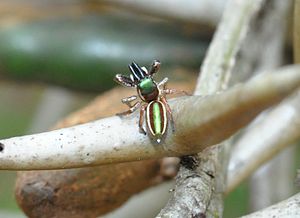Bagheera kiplingi
| Bagheera kiplingi | ||||||||||||
|---|---|---|---|---|---|---|---|---|---|---|---|---|

Bagheera kiplingi |
||||||||||||
| Systematics | ||||||||||||
|
||||||||||||
| Scientific name | ||||||||||||
| Bagheera kiplingi | ||||||||||||
| Peckham & Peckham , 1896 |
Bagheera kiplingi is a Central American species from the jumping spider family. It shows some behavior patterns that are unusual for spiders and therefore plays a special role in zoological and evolutionary research. It is considered to be the only currently known spider that feeds mainly on plants.
features
Bagheera kiplingi is a brightly colored jumping spider with a pronounced sexual dimorphism , with the males having amber legs and a dark prosoma (cephalothorax). The prosoma is slightly greenish in front, the abdomen ( opisthosoma ) is shimmering reddish with greenish diagonal stripes. The females have strong forelegs, the other legs are much slimmer and pale yellow. Your cephalothorax is red-brown with a frontally black-colored region. Females have a larger abdomen that shows dark brown and green spots on a brownish background.
distribution
The species has been detected in Mexico , Guatemala and Costa Rica and is widespread there.
Way of life
The jumping spider feeds 60 to 90 percent on protein and fat-rich food bodies ( Belt's bodies ) of certain acacias ( Vachellia collinsii , V. cornigera ). These fodder bodies primarily serve the symbiotic ant species Pseudomyrmex peperi, P. spinicola, P. flavicornis and P. nigrocincta , which live symbiotically on these acacias, as the basis of food, whereby the acacias are protected from predators by the ants. Other food components are nectar, occasionally ants and their larvae and small species of flies that feed on nectar.
The spider lives all year round on older branches of the acacia, which develop very few of the nutrient-rich food bodies and are therefore rarely visited by ants, and also reproduces there. In search of food, it goes on young shoots that develop many food bodies and comes into contact with the ants, camouflaging itself through its ant-like movement and evading pursuit through very rapid movements and flexible evasive behavior. The young of Bagheera kiplingi resemble the ants that live on the acacias. This mimicry protects them from predators and possibly also from the ants themselves.
Systematics
The genus name is derived from the name of the black panther Bagheera from Rudyard Kipling's The Jungle Book , the Artepitethon from the author's last name. In 1896 only males of the species were described; the females were not discovered until Wayne Maddison over a hundred years later. Another species of the genus, called Bagheera prosper , is also known.
literature
- Christopher J. Meehan, Eric J. Olson, Matthew W. Reudink, T. Kurt Kyser, Robert L. Curry: Herbivory in a spider through exploitation of an ant – plant mutualism. In: Current Biology. 19, No. 19, 2009, pp. 892-893 ( doi : 10.1016 / j.cub.2009.08.049 ).
- Duncan E. Jackson: Nutritional Ecology: A First Vegetarian Spider. In: Current Biology. 19, No. 19, 2009, pp. 894-895 ( doi : 10.1016 / j.cub.2009.08.043 ).
Web links
- Bagheera kiplingi in the World Spider Catalog
- Christopher J. Meehan et al. a .: Exploitation of the Pseudomyrmex – Acacia mutualism by a predominantly vegetarian jumping spider (Bagheera kiplingi). 93rd ESA Annual Meeting, August 2008 (English)
- The unusual menu of Bagheera kiplingi. On: Wissenschaft.de from October 13, 2009.